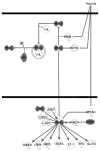Increased vascular permeability after cardiopulmonary bypass in patients with diabetes is associated with increased expression of vascular endothelial growth factor and hepatocyte growth factor
- PMID: 19577077
- PMCID: PMC2762706
- DOI: 10.1016/j.jtcvs.2008.12.024
Increased vascular permeability after cardiopulmonary bypass in patients with diabetes is associated with increased expression of vascular endothelial growth factor and hepatocyte growth factor
Abstract
Background: Several inflammatory mediators such as vascular endothelial growth factor and hepatocyte growth factor are known to play a critical role in the regulation of vascular permeability and angiogenesis. We studied the serum levels of growth factors and gene expression profiles of genes involved in growth factor signaling in the peripheral blood of patients with and patients without diabetes following cardiopulmonary bypass and cardioplegic arrest.
Methods: Serum and total RNA were obtained from the blood samples collected from patients with diabetes and matched patients without diabetes (n = 7 patients each) who had coronary artery bypass graft before and 6 hours and 4 days after cardiopulmonary bypass/cardioplegic arrest. The cytokine panel, consisting of growth factors such as vascular endothelial growth factor, hepatocyte growth factor, fibroblast growth factor, and epidermal growth factor, was quantified in patients with diabetes and patients without diabetes before and 6 hours and 4 days post-cardiopulmonary bypass/cardioplegic arrest using multiplex cytokine quantification system. cDNA microarray analysis was performed and fold-change was calculated.
Results: Length of hospitalization (10 vs 6 days; P = .04) and weight gain (5 vs 2.5 kg; P = .001) were significantly greater for patients with diabetes compared with patients without diabetes. The serum levels of vascular endothelial growth factor and hepatocyte growth factor were significantly elevated in patients with diabetes when compared with patients without diabetes before versus 6 hours post-cardiopulmonary bypass/cardioplegic arrest. In addition, significantly elevated mRNA expression of hypoxia-inducible factor-1alpha, cyclic adenosine monophosphate response element binding protein, and E1A binding protein p300 (more than twofold) was observed 4 days post-cardiopulmonary bypass/cardioplegic arrest exclusively in patients with diabetes.
Conclusions: The differential profile of gene and protein expression of growth factors and their related genes in patients with diabetes and patients without diabetes could be associated with increased edema and weight gain in patients with diabetes after cardiopulmonary bypass/cardioplegic arrest.
Figures








Similar articles
-
Differences in gene expression profiles of diabetic and nondiabetic patients undergoing cardiopulmonary bypass and cardioplegic arrest.Circulation. 2004 Sep 14;110(11 Suppl 1):II280-6. doi: 10.1161/01.CIR.0000138974.18839.02. Circulation. 2004. PMID: 15364876
-
Gene expression profile after cardiopulmonary bypass and cardioplegic arrest.J Thorac Cardiovasc Surg. 2003 Nov;126(5):1521-30. doi: 10.1016/s0022-5223(03)00969-3. J Thorac Cardiovasc Surg. 2003. PMID: 14666028
-
Myocardial VEGF expression after cardiopulmonary bypass and cardioplegia.Circulation. 1998 Nov 10;98(19 Suppl):II242-6; discussion II247-8. Circulation. 1998. PMID: 9852909
-
Roles of p300 and cyclic adenosine monophosphate response element binding protein in high glucose-induced hypoxia-inducible factor 1α inactivation under hypoxic conditions.J Diabetes Investig. 2017 May;8(3):277-285. doi: 10.1111/jdi.12592. Epub 2017 Jan 24. J Diabetes Investig. 2017. PMID: 27808477 Free PMC article.
-
Microvascular dysfunction in patients with diabetes after cardioplegic arrest and cardiopulmonary bypass.Curr Opin Cardiol. 2016 Nov;31(6):618-624. doi: 10.1097/HCO.0000000000000340. Curr Opin Cardiol. 2016. PMID: 27652811 Free PMC article. Review.
Cited by
-
Changes in microvascular reactivity after cardiopulmonary bypass in patients with poorly controlled versus controlled diabetes.Circulation. 2012 Sep 11;126(11 Suppl 1):S73-80. doi: 10.1161/CIRCULATIONAHA.111.084590. Circulation. 2012. PMID: 22965996 Free PMC article.
-
Narrative review of the systemic inflammatory reaction to cardiac surgery and cardiopulmonary bypass.Artif Organs. 2022 Apr;46(4):568-577. doi: 10.1111/aor.14171. Epub 2022 Jan 21. Artif Organs. 2022. PMID: 35061922 Free PMC article. Review.
-
Effects of diabetes and cardiopulmonary bypass on expression of adherens junction proteins in human peripheral tissue.Surgery. 2017 Mar;161(3):823-829. doi: 10.1016/j.surg.2016.08.057. Epub 2016 Nov 9. Surgery. 2017. PMID: 27838104 Free PMC article.
-
Decreased contractile response to endothelin-1 of peripheral microvasculature from diabetic patients.Surgery. 2011 Feb;149(2):247-52. doi: 10.1016/j.surg.2010.07.003. Epub 2010 Aug 21. Surgery. 2011. PMID: 20727565 Free PMC article.
-
Differential impairment of adherens-junction expression/phosphorylation after cardioplegia in diabetic versus non-diabetic patients.Eur J Cardiothorac Surg. 2016 Mar;49(3):937-43. doi: 10.1093/ejcts/ezv202. Epub 2015 Jun 11. Eur J Cardiothorac Surg. 2016. PMID: 26069241 Free PMC article.
References
-
- Lauruschkat AH, Arnrich B, Albert AA, Walter JA, Amann B, Rosendahl UP, et al. Prevalence and risks of undiagnosed diabetes mellitus in patients undergoing coronary artery bypass grafting. Circulation. 2005 Oct 18;112(16):2397–402. - PubMed
-
- Furnary AP, Zerr KJ, Grunkemeier GL, Starr A. Continuous intravenous insulin infusion reduces the incidence of deep sternal wound infection in diabetic patients after cardiac surgical procedures. Ann Thorac Surg. 1999 Feb;67(2):352–60. discussion 60-2. - PubMed
-
- Krinsley JS. Association between hyperglycemia and increased hospital mortality in a heterogeneous population of critically ill patients. Mayo Clin Proc. 2003 Dec;78(12):1471–8. - PubMed
-
- Eberhardt F, Mehlhorn U, Larose K, De Vivie ER, Dhein S. Structural myocardial changes after coronary artery surgery. Eur J Clin Invest. 2000 Nov;30(11):938–46. - PubMed
-
- Semenza GL, Agani F, Feldser D, Iyer N, Kotch L, Laughner E, et al. Hypoxia, HIF-1, and the pathophysiology of common human diseases. Adv Exp Med Biol. 2000;475:123–30. - PubMed
Publication types
MeSH terms
Substances
Grants and funding
LinkOut - more resources
Full Text Sources
Medical
Miscellaneous

